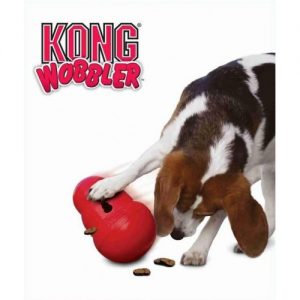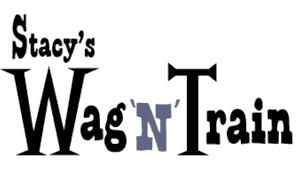Ditch the bowl!
List of recommended enrichment products
You can help relieve stress and boredom by finding ways to occupy the dog’s time with toys and activities that might give him an outlet for energy in a more “creative” or mental way. This often involves food puzzles which will allow you to “ditch the bowl” and make sure every meal is fed through a stuff-toy, puzzle-feeder, food-dispenser, snuffle-mat, scatter, or hide-and-seek setups. Even a chewing “project” – like a large, meaty bone – can be a great form or enrichment. Sometimes even dogs who show little interest in their food as it sits in the bowl will learn to enjoy food-puzzle toys – or you can use some of the “make it more desirable” tips below.
Note that links are to sample products, usually for medium to large dogs – you might need a different size or type for your dog. Also, these are affiliative links. As an Amazon Associate I earn from qualifying purchases (in theory!).
Food-dispensing toys
Hard rubber food-stuffing toys – use wet food or wet/dry mix; you can make harder by blocking opening with large biscuit or chunk of carrot. Don’t leave these toys empty for your dog to chew on if they destroy them!
Kongs – use black “extreme” Kongs for stronger dogs
Busy Buddy Squirrel Dude
Hard plastic food dispensing toys – use dry food (kibble) or hard, dry treats; you can make harder by adding rubber ball or pebble larger than opening, or by adding crumpled paper. These toys are chosen because they are durable, easy to fill, and easy to open up and clean out.
Kong Wobbler (see a video comparing a Wobbler’s use to a plain bowl, here)
Green slow-feeder (dry or wet)
Nina Ottosson puzzles: Dog Smart, Casino, Tornado, Hide N’ Slide, Maze, or Twister (dry or small amounts of wet)
Use your lawn – toss kibble across your grassy lawn and let your dog sniff it out! Note: do not do this if your dog is likely to chew up your plants, or if the lawn in question is also the dog’s potty.
Chews
Raw, meaty bones (buy fresh from butcher or super market or wholesale raw food supplier)
Bully sticks (possibly combined with Kong or Qwizl toy)
Hooves, filled hooves (one of Fletcher’s favorites!)
Make it more challenging for the dog
- Hide the toy or chew somewhere in your house or yard, then release your dog to go find it
- Freeze a wet-food dispensing toy overnight
- Have more than one type of food-dispensing toy per meal or alone-time
- Put toy or chew under a towel or blanket (only for dogs who are unlikely to chew on the towel or blanket) so that your dog has burrow underneath to get the toy first
- Wrap toy or chew in newspaper, or seal in cardboard box, that dog has to rip through first (only if dog isn’t going to swallow paper products and you don’t mind the mess!)
Make it more desirable for the dog
- Mix treats in with dry kibble
- Add small amounts of oil (fish, olive, or coconut) to regular food
- Mix in grated parmesan or other strong dry cheese to food
- Crush freeze-dried liver cubes and mix in to food
- Add dog-safe leftovers to food
- Add a dash of salt to food
- Dip old bones or other hard chews in broth or fish oil, or smear with peanut butter
- Rotate toys in and out of circulation
Make it easier for you
- Mix up a big bowl of wet or wet-dry food and add-ins (fish oil, probiotics, leftovers, fruit, vegetables, supplements) and fill multiple food-dispensing toys at once for multiple meals
- Use a muffin tray to hold Kong-type toys in place while filling or freezing
- Wet the outside of rubber (Kong-type) toys while filling to make clean-up easier
- Confine dog to easy-clean surfaces (tile, linoleum, bare crate floor) while eating/chewing
- Get a toy-cleaning brush to scrub inside of Kongs and similar toys
- Run rubber or hard-sided toys through dishwasher (they might fade in color, but should withstand it!)
Other enrichment aids
Go for an off-leash or long-line “sniffari”. If your dog cannot be legally and safely off leash, use a body harness and an extra long leash (20-40 feet). Note that there is a “learning curve” in learning to handle a long leash – being able to pay it out and collect it back in. I do NOT recommend “flexi” type retractable leashes as these can lead to dangerous rope burns, the handles are heavy and fill your hand, and the brakes don’t always work like you expect. You can’t let a flexi-type leash drag on the ground. Please note that some parks and cities specify that dogs must be on a leash that is no more than 6 feet in length; please follow your local laws!
Recommended harnesses
- Balance – http://www.petexpertise.com/dog-gear/dog-harnesses/no-pull-dog-harnesses/balance-harness.html
- Front Range – http://www.petexpertise.com/dog-gear/dog-harnesses/no-pull-dog-harnesses/front-range-dog-harness-ruffwear.html
- Perfect Fit – https://www.dog-games-shop.co.uk/perfect-fit-fleece-dog-harness.html
- Freedom – http://www.petexpertise.com/dog-gear/dog-harnesses/no-pull-dog-harnesses/freedom-no-pull-dog-harness-multi-functional-with-velvet-cushioning.html
Alternative long-lines
- Biothane leads – less likely to get caught on bushes, rocks etc – https://k9tacticalgear.com/collections/biothane-beta-leads or Viper Leads
- “Check cord” – rounded lines
Note: As an Amazon Associate I earn from qualifying purchases.

